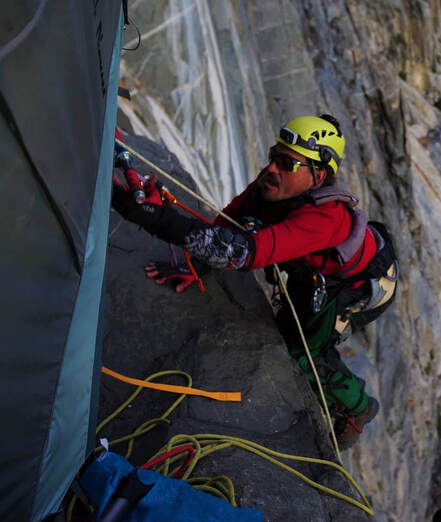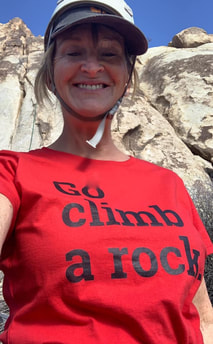Photo Credit: Wilkinson Visual from the Paradox Sports Collection (our featured photos for the month)
Welcome to the March 2020 Adaptive Climbing Edition of Common Climber!
Together, let's bring adaptive climbing out of the sidelines and into the mainstream!
Together, let's bring adaptive climbing out of the sidelines and into the mainstream!
Guest Editorial: Enock Glidden
We All Need Climbing Partners
As a paraplegic due to spina bifida, I have had the opportunity to experience many things throughout my life. Most of those experiences involved the help of friends or family in some way. I have skied downhill and cross country, wheelchair raced, played on a basketball team, and done just about everything anyone else can do. I have even walked with braces. All of those things involved at least a little help from someone else.
I had an amazing physical education teacher, Bob Dyer, who got me into trying most of those activities. It is because of him that I knew I could do rock climbing. I wasn’t sure exactly how, but I knew it could be done. I believe anything can be done with the right amount of ingenuity and teamwork.
I had an amazing physical education teacher, Bob Dyer, who got me into trying most of those activities. It is because of him that I knew I could do rock climbing. I wasn’t sure exactly how, but I knew it could be done. I believe anything can be done with the right amount of ingenuity and teamwork.
|
Six years ago, I took the initiative to figure out how to rock climb. I was inspired by the loss of my friend Nick Hall. Nick was a rescue ranger at Mt. Rainier and unfortunately lost his life while performing a rescue. It was that day I checked out the amazing photos of the places climbing had taken him. I decided I had to see those places for myself. I googled adaptive climbing and found Paradox Sports. They are a nonprofit out of Colorado that teaches people with disabilities how to climb rock, ice, and indoors. I went to their Gunks trip that fall and the rest is history.
I want you to think about all of your climbing experiences. Did you do it all by yourself or was there someone who taught you how along the way? Did someone belay for you? Did you get help carrying gear? You see all of these things involved someone else. We like to think we are independent and yes If we can do something for ourselves, we should. We also should not be afraid to ask for help. That also goes in the other direction. We should not be afraid to offer help. As climbers we should want everyone to experience the amazing joy, accomplishment, and other emotions we get from climbing. |
People with disabilities just want to be able to do everything we can in life, just like everyone else. I think sometimes people are afraid to offend us or say the wrong thing. Really, it all comes down to treating everyone like a human. I am no different than anyone who can stand. If I am jerk tell me so. If I do something awesome you can tell me that too. Approach us like you would anyone in your life. It all starts with, "Hi my name is…." and just let it flow from there.
Maybe once we meet we can all climb to greater heights together.
Maybe once we meet we can all climb to greater heights together.
Adaptive Climbing Photo Feature: Paradox SportsParadox Sports is a non-profit organization that supports adaptive climbing across the U.S. Check out these amazing photos and learn more about this incredible organization.
|
Articles
|
Blind Ambition Builds a World Class Climber: The Story of Jesse Dufton (By Dave Barnes)
United Kingdom climber Jesse Dufton has Rod-Cone Dystrophy, a genetic disorder where his eyes do not have the structural support for the light sensitive cells at the back of the eye. This has slowly eroded his vision, taking him into the world of climbing blind. Jesse, who has been climbing since a young age, has adapted - and he still leads trad. |
Rock! (By Paul Pritchard) Multi-award winning book author Paul Prichard shares a very special story about sharing climbing with his son Eli...The day had finally arrived when I could safely take my boy climbing. I had waited a long time for this moment. As a D.A.D. (dad with a disability) it takes a whole lot of planning to do anything adventurous with your kids. I have a brain injury, you see, after a climbing accident twenty-two years ago... |
The Unreasonable Man (By Wayne Willoughby)
The Unreasonable Man is a touching story of sheer will, persistence, ambition, and, most of all, a love of climbing. The author, who was struck by Polio at a young age, battles major surgeries, significant injuries, and a deteriorating body from Post Polio syndrome. Yet, he sets big wall speed records and climbs numerous big walls per year. |
|
First Paralyzed Ascents: Rand Abbott (Interview by Enock Glidden)
Rand Abbott is a climber in Joshua Tree, California who has numerous First Paralyzed Ascents in the park. Rand shares his thoughts and experiences in an interview with Enock Glidden. Local JTree legend and long-time climbing partner with Rand, Todd Gordon, chimes in too... |
|
Climbing with Type 1 Diabetes
(By Lori Miles) Type 1 Diabetes may not be something that would typically come to mind when you think of adaptive climbing, but adaptive climbing means having to make significant adjustments for a condition that affects you on a daily basis. Lori Miles explains how Type 1 Diabetes impacts her life, climbing, and the adaptations she has to make to ensure she can climb safely. |
Mixed Climbing: My Answer to KT Syndrome
(By Matt Westlake) 21 years ago, at the age of 7, I was diagnosed with Klippel Trenaunay (KT) Syndrome - a rare disease that causes my veins to grow uncontrollably like cracks through a shattered window. Blood begins to pool, which causes poor circulation, blood clots, and lymphedema, along with a string of many other health issues... Six years ago I found climbing... |
Paraclimbing Competitions: Athlete Interviews
(by Enock Glidden) Enock Glidden shares some history and basics of paraclimbing competitions, as well as, fun interviews of paraclimbing athletes Ben Mayforth and Molly Ferris. |











